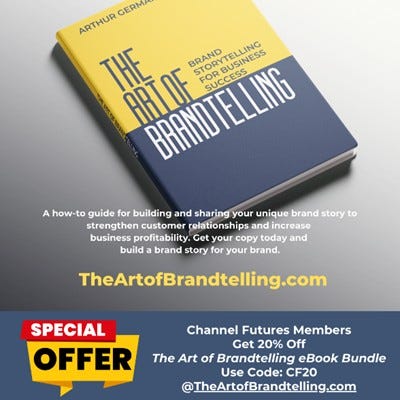Learn to Create, Capture and Curate Stories for Your BrandLearn to Create, Capture and Curate Stories for Your Brand
The first step is developing your own stories. These are about how your company was formed, who founded it and why it was created.
September 21, 2023


Arthur Germain
If you’ve been reading my previous articles, you are likely beginning to follow some of the guidance I’m offering. You understand why brand storytelling is important, you’ve begun to find your own brand voice and you’re ready to tell your own brand story.
Great! Now what?
Now it’s time to build your Brand Storybook. This is where you collect the stories about your brand that you can use when developing website content, sales presentations and collateral for trade shows and events. The Brand Storybook is where all of your collected corporate wisdom, customer success stories, descriptions of the benefits and values that your services and products provide and biographies about your employees will reside.
Build Your Brand Storybook: Create, Capture, Curate
To be honest, it’s not really a book. I develop Brand Storybooks for companies that range from a few pages to dozens of separate articles. The former exists as a document while the latter may exist as a series of documents in a Google Drive. In any case, it becomes a focal point and building block for your branded content. Try to organize your documents using a repository – a network drive, cloud drive or a purpose-built brand management solution, a digital asset management (DAM) tool – where you can control access and provide updates to your team. Here are the three steps I recommend that you can use to do this within your own organization.
1. The first step is developing your own stories. These are the stories about how your company was formed, who founded the company and why it was created. Avoid self-aggrandizing here – you want to capture the essence of your founding stories and the benefits that your services and products deliver – not the features which are going to change over time.
 For example, let’s say you’re an MSSP and you offer some type of cybersecurity incident response services based on Cisco Talos. You don’t want to create a brand story that is book and verse about Cisco Talos. They’re great — and they craft their own content. You want to craft a story about the benefits that your service delivers and why it is an absolute necessity for your target customer.
For example, let’s say you’re an MSSP and you offer some type of cybersecurity incident response services based on Cisco Talos. You don’t want to create a brand story that is book and verse about Cisco Talos. They’re great — and they craft their own content. You want to craft a story about the benefits that your service delivers and why it is an absolute necessity for your target customer.
If you serve the legal services market with 24-hour emergency response capabilities, stress the fact that you can help get your clients up and running quickly while maintaining the integrity of their client data. How you do that, and the features that your service and Talos offer are less important – and are going to change over time as technology changes – but the customer focus and industry understanding are going to remain hallmarks of your brand. That’s where you want to focus as you craft and create these stories.
Create articles, blogs, podcasts and webinars that highlight your brand, the benefits you provide your customers along with the experience and expertise that only your company can deliver.
2. This is the easiest part of the steps for collecting your stories, but many organizations somehow manage to mess this up. This is where you want to focus on the outcomes that you and your team have delivered for clients. This is also where you want to focus on the capabilities and experiences that your employees possess. You want to capture customer testimonials that focus on your brand benefits. What do I mean? Try and avoid capturing customer testimonials that are bland: “We love working with XYZ Corp. They are so great to work with. Blah, blah, blah.” It’s great that they like you, but you want …
… a testimonial that says why they like you and what you helped them accomplish. I have a customer testimonial on my website that says:
“Arthur was able to work with me and my team to create a brand identity that speaks to our target audience. Before beginning any type of marketing campaign, it is very worthwhile and important to know your brand. It is worth a revisit if you have not done a brand analysis and definitely worth investing if you are creating a new brand. I highly recommend Arthur and his Brandtelling services.”
See how specific and helpful this is for future clients? That’s what you want in your testimonials as well. In a similar vein, you want to craft customer success stories rather than case studies. I find the latter to be too formulaic and more of a backward look at what you did, rather than what the customer was able to accomplish. Case studies tend to drag in product names or lists of applications that were used during an engagement. Success stories focus on benefits and outcomes delivered. They demonstrate how your client was able to rise above a challenge and accomplish new goals, create new revenue streams and expand into new regions.
When it comes to your employee bios — these are types of stories that you want to create as well. I see too many companies fall into the trap of what I call “looking over their shoulders” instead of looking ahead. It’s too easy to craft a new employee, executive or subject-matter bio that simply states your employee’s new title and then lists their prior work experience. That’s a waste of time; someone can check LinkedIn to find that information. Instead, focus on crafting a narrative about what your employee offers in their new or current role at your firm and how their experience has come to benefit your customers. Also, avoid saying things like “John holds a B.S. in computer science from CMU.” It’s much more accurate and impressive to say, “John earned a Bachelor of Science in computer science with a concentration in security and privacy from Carnegie Mellon University.”
3. This is the most difficult part of the exercise. Now it’s your job to select among the content that you have created and captured — and throw away the things that aren’t working. This task is often conducted as a content audit of your branded collateral and it’s something that you and your communications or marketing team should perform at least once per year.
Review your website, subject-matter-expert content and marketing collateral. Compare those to the Brand Storybook. What works, what stands out, what’s missing, and what simply no longer works? If your company is offering a new service that replaced an old service, then you need to update and refresh your content. If you have older “case studies” it might be time to do the same — or replace them with newer “customer success stories” that tell a better tale about working with your business.
You can carry the curation portion of this exercise into your social media sharing as well. Stop recycling older posts that no longer make sense or no longer serve the direction of your firm. You can also curate content from other sources that you wish to share or add your commentary to and then share. If you are that MSSP working with Talos from my earlier example, you might share their latest report or data along with commentary from your own team to make it more specific, useful and relevant you your customers. This could be part of an email from your company that discusses and highlights the latest findings on ransomware, links to the Talos report, and then offers your own thoughts about what customers should do to remain safe.
Mastering creating, capturing and curating content is the key to developing and maintaining strong story leadership for your brand. It’s an ongoing process, just like every other operation in your business, and it will pay dividends in making your brand messages more consistent, relevant and powerful to your customers.
More articles from this author:
Arthur Germain is the principal and chief brandteller at Brandtelling. Follow him on LinkedIn. He has recently authored a book called The Art of Brandtelling: Brand Storytelling for Business Success available in paperback, Kindle and eBook formats. Visit https://TheArtofBrandtelling.com for information.
About the Author
You May Also Like


